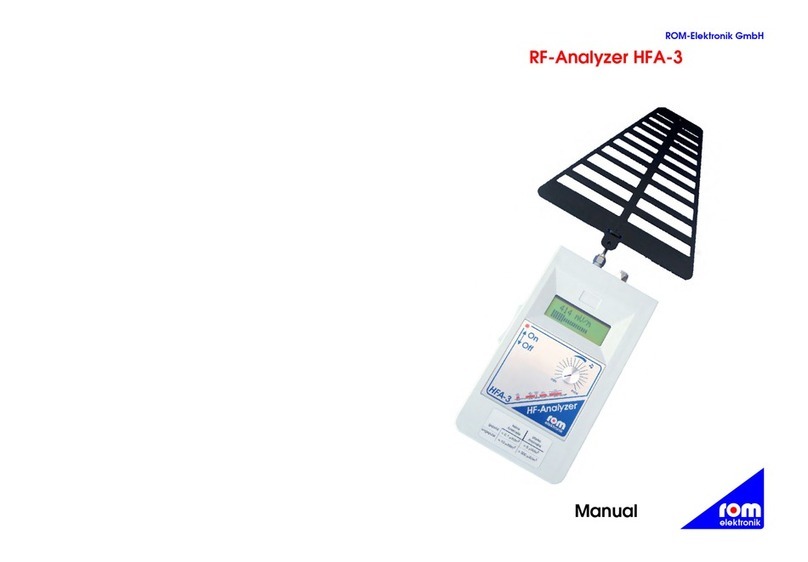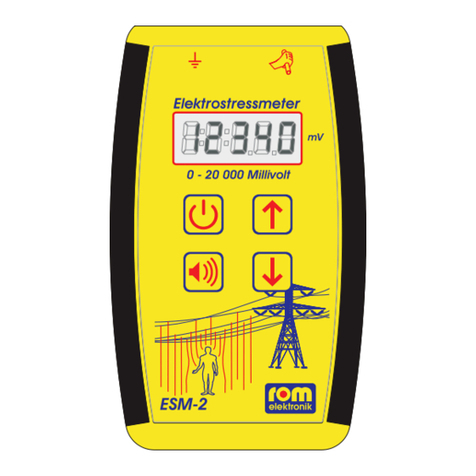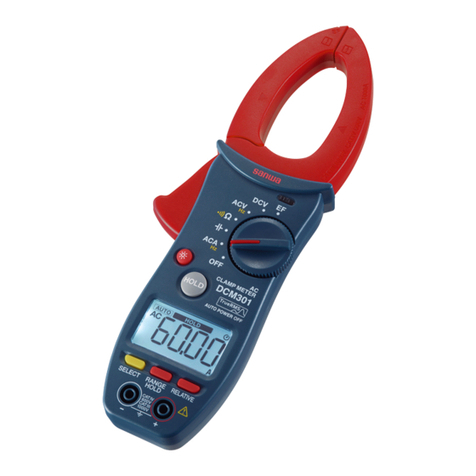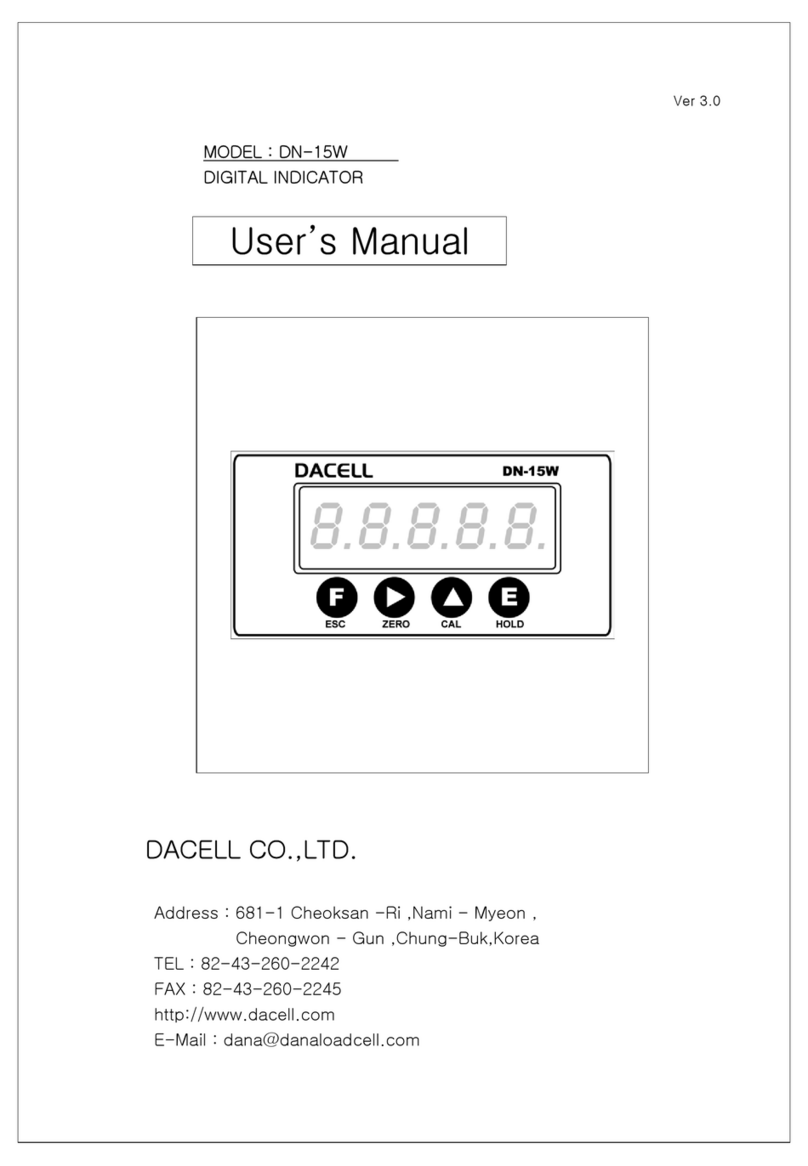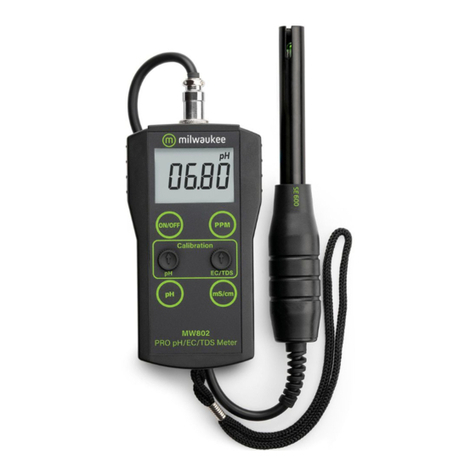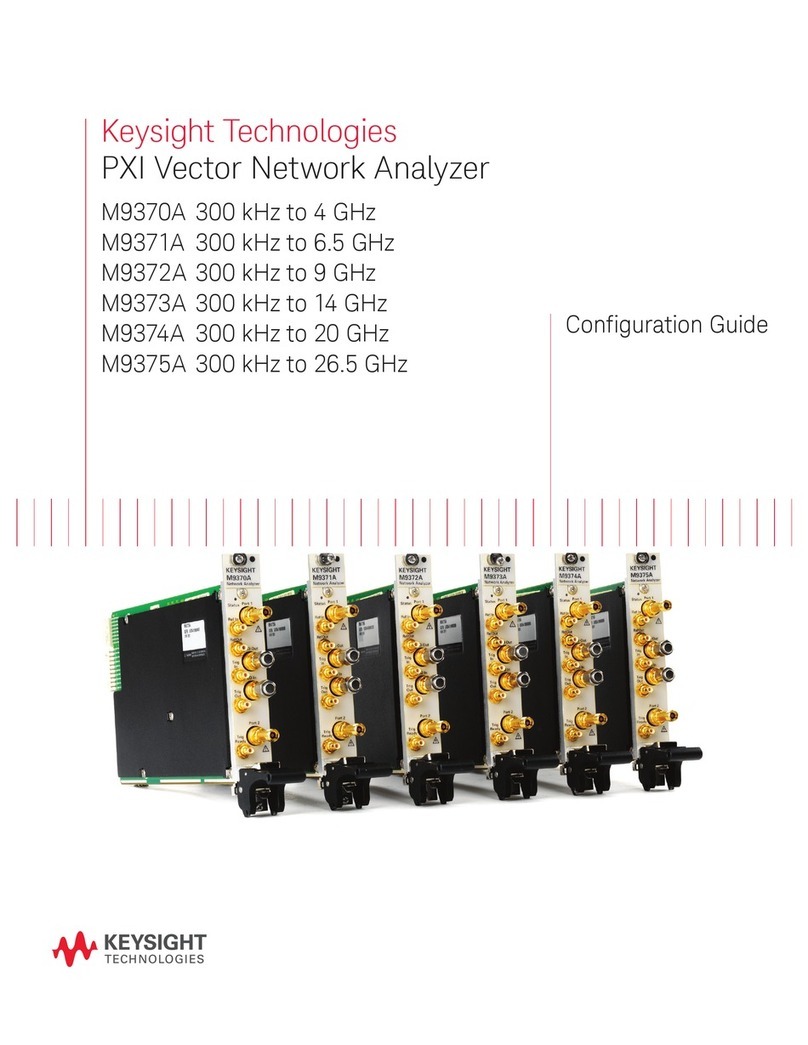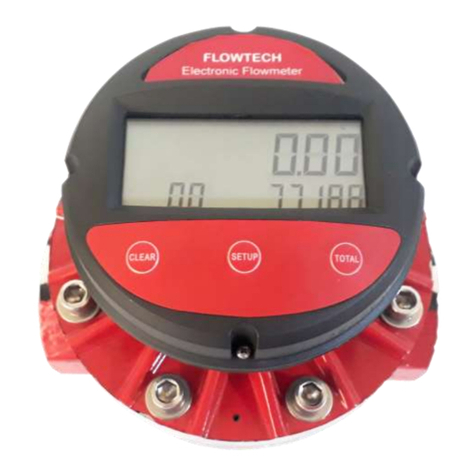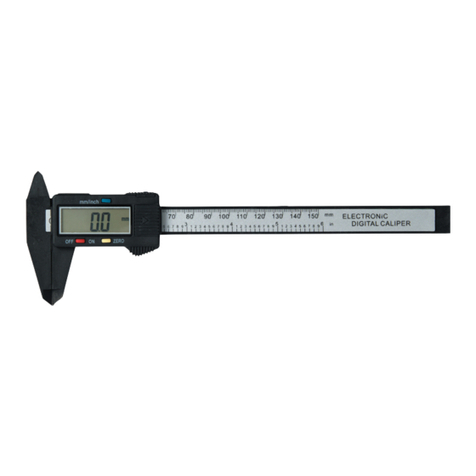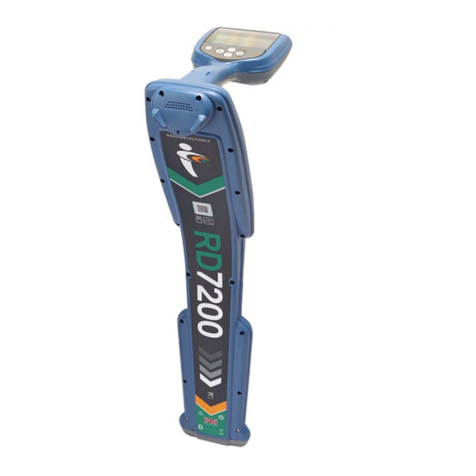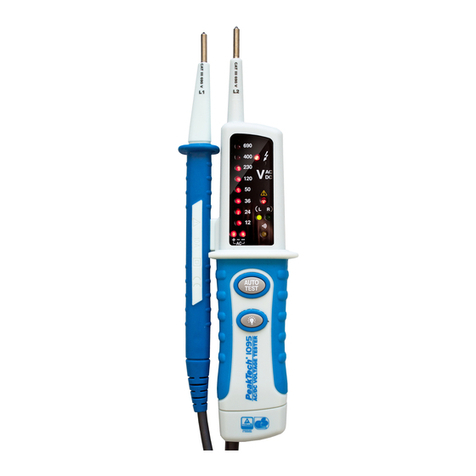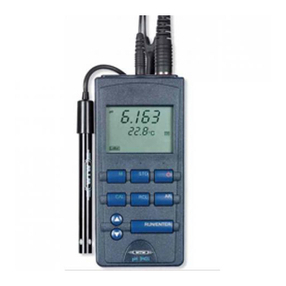ROM Elektronik E-Field 1 User manual

E-Field 1
ROM-Elektronik GmbH
Am Grund 13
D-86489 Deisenhausen
©ROM-Elektronik GmbH
Page 1

Manual
Table of Contents
Page
Safety instructions!4
Operating elements!5
Display!5
On / Off Switch!5
Range Selector Switch!6
Filter for Frequency Analysis!6
Battery Compartment!7
Properties of AC electric fields!8
Comments on Measuring Technology!9
Preparation of measurement!9
Performing the measurement!11
Changing the Battery!13
Universal Applications!13
Corrective measures!13
Reduction of AC electric fields!13
Liability and Warranty!14
Help and Support!14
Technical Data!14
©ROM-Elektronik GmbH
Page 2

Thank you for choosing to purchase this equipment.
The E-Field 1 sets new standards in measuring technology for the
potential-free measurement of AC electric fields. Professional
measuring technology was implemented with a worldwide unique
price-performance ratio. This was made possible by our many years
of experience and the consistent use of innovative circuit elements
as well as the latest production methods.
The device you have purchased allows a qualified assessment of
loading electrical alternating fields in the range of min. 10 Hz to 400
kHz.
We thank you for the confidence you have shown us with the
purchase of E-field 1. We are convinced that it will fully meet your
expectations and want to provide you with useful knowledge on the
device.
The E-field 1 enables you to make potential-free measurement of
AC electric fields. The built-in filter ranges from 16 Hz bandpass to
50 Hz and 2 kHz highpass. The measurement ranges are at 200 V/
m and 2000 V/m.
Manufacturer:
ROM-Elektronik GmbH
Am Grund 13
D-86489 Deisenhausen
The device may not be disposed of in household waste.
©ROM-Elektronik GmbH
Page 3

Safety instructions
It is imperative for you to read through this manual carefully before
the first setup.
There are important instructions for safety, use and maintenance of
the equipment.
To avoid the destruction of the measuring device, do not bring it into
contact with water. In particular, the entry of water into the housing
can damage the electronics. Do not store the device outdoors or
use in the rain.
Clean only the outside with a damp cloth. Do not use cleaners or
sprays.
Prior to cleaning or opening the device, turn it off and remove all
cables connected to the device. There are no user-serviceable parts
inside the device.
Due to the high measuring accuracy, the electronics are sensitive to
heat, impact and touch.
Therefore do not place it in direct sunlight or heat, etc. and do not
allow it to drop.
Please use this device only for the intended purposes, and use only
supplied or recommended accessories.
©ROM-Elektronik GmbH
Page 4

Operating elements
Display
It digitally displays the measured values and the device functions.
On / Off Switch
If the switch on the left side of the device is pushed upwards, the
device is turned on. The switch has three possible positions: OFF-
ON-ON with SOUND. To conserve battery power, it is advisable to
turn off the E-Field 1 during longer measurement breaks.
©ROM-Elektronik GmbH
Page 5
Display
On/Off-Switch
Range Selector Switch
Filterswitch
Sensor

Range Selector Switch
By turning the switch, the following measuring ranges can be
selected: electric field in V/m (Volt per Meter)
•0 - 200 V/m
•0 - 2000 V/m
Filter for Frequency Analysis
The frequency filter module built into the E-Field 1 is is especially
optimized for the needs of structural biology.
It includes the following switch positions:
1. 10Hz to 400kHz = full bandwidth,
2. 16Hz = Band pass filter for the frequency of
railway current
3. 50Hz to 400kHz = High-pass filter for power
and its harmonics
4. 2kHz to 400kHz = High-pass filter, for the so-
called "artificial" harmonics above 2
Kilohertz. This frequency range corresponds
to the volume 2 of the TCO standard.
©ROM-Elektronik GmbH
Page 6

Battery Compartment
This is located at the back of the device. The device is to be
inserted with a 9V alkali-manganese block battery or an equivalent
battery.
Setup
Before the first measurement, please perform the following steps in
sequence:
©ROM-Elektronik GmbH
Page 7

•Open the battery compartment on the back of the device and
make sure that the device is turned off (on / off switch in lowest
position).
•If the battery is wrapped in film, remove it. Then press the battery
clip on the battery (observe polarity!). Insert the battery into the
battery compartment and close it.
•Turn the device on (switch upwards).
•Turn the measuring range switch to the desired measuring range.
Properties of AC electric fields
In general, electrical fields can not be perceived with the human
sense organs. They are "just there" under certain conditions and
extend to very complex laws in three dimensional space. For the
practical implementation of measurement, the following properties of
alternating fields are of particular importance:
•A measurement is always sensitive to location and direction, i.e.
even a small change in the location or the orientation of the
measuring device can have serious effects on the measured
value.
•Electric fields enter into solid materials, including walls, glass, etc.,
or even penetrate them.
•Alternating electric fields are generated wherever an AC voltage is
applied, i.e. in the household, for example, to all power cords to a
connected electrical device or its switch. And even if this device is
turned off!
•In addition to the field strength, an AC electric field is defined more
by its frequency. We differentiate those considered as low-
frequency range from 16 Hz to 30 kHz and high-frequency fields,
which include all higher frequencies. There are also static or DC
©ROM-Elektronik GmbH
Page 8

fields, for which a completely new measuring technology is
required for the high-frequency radiation.
Comments on Measuring Technology
For a meaningful measurement, the following minimum
requirements on the measuring technology for low-frequency
alternating fields were setup in the SBM2008:
•Potential-free measurement of AC electric fields.
•Reproducible, high accuracy.
•Compensated frequency response over the entire specified
frequency range, which should go at least from the railway current
frequency with 16.67 HZ to the kilohertz range.
•High resolution: 0.1 V/m or better.
The measuring devices of ROM-Elektronik can meet all these
requirements.
Preparation of measurement
1. Check the measuring device in accordance with the instructions
in the chapter "Before setup".
2. Beforehand, a measurement of the AC electric field is to be
conducted outdoors in order to determine the basic load. If a
basic load over 2 V/m is displayed, a classification of the basic
load can be performed beforehand. Switching off the circuits by
means of the automatic circuit breaker in your own house fuse
box determines which fields are from the house and which are
from other field sources, for example, generated from high-
voltage lines, railway power, transformers or installations
adjacent neighboring homes. If external field sources are
responsible, higher field strengths can be localized there.
©ROM-Elektronik GmbH
Page 9

3. For a home or workplace measurement all typical loads should
be switched on, even those that turn on only temporarily, for
example, refrigerators, electrical storage heating (also in
adjoining rooms). By turning individual loads on and off, the main
causes can be isolated.
4. A sketch of the location to be measured and logged measured
values allow for a subsequent analysis of the situation. In this
manner, appropriate corrective measures are derived.
5. The measurement starts in the measurement area "200 V/m"
and switches only where the display overflows due to high field
strength (only one 1 is to be seen in the display ist) in the
general area "2000 V/m".
6. All measurements should be repeated at different times of day
and days of the week to determine fluctuations.
7. The switchable, field strength proportional tone simplifies a
sound measurement.
©ROM-Elektronik GmbH
Page 10

Performing the measurement
The measuring device is calibrated on a potential-free measurement
of AC electric fields away from the body. i. e., the measuring device
should be located as far away from the body as possible when
measuring electric fields. For this, use the supplied mounting rods.
The mounting rods are screwed together. In one of the supplied
mounting rods, there is a small hole through which the screw fits on
the device. This is necessary so that the E-Field 1 is attached
securely to the rod.
By the directional characteristics of the measuring device, finding
and locating the field source is possible by rotating the probe.
©ROM-Elektronik GmbH
Page 11

With the sensor of the E-Field-1 "points" to the suspected field
sources or, if no specific field sources are known, the space
systematically examined. Proceed as follows:
•for a first overview, go slowly around the room
•pause often and measure the field strengths to the back, left, right
and above.
•the measurement in the direction of the highest reading in order to
identify the field sources, or,
•if a typical location for a long delay is reached e.g. the bed or the
workplace, check all directions according to the above instructions
and hold the sensor in the position of the highest display.
•the measured value which is measured in the direction of the
highest display can be used as a first approximation as the
resulting field strength.
The probe should be led quietly and smoothly, as abrupt
movements result in temporarily artificially high values of electric DC
fields.
An examination of a sleeping place should also be measured in
each case under "sleeping conditions", i.e. with a bedside lamp
Sensor measurement direction
©ROM-Elektronik GmbH
Page 12

turned off. The electric field may even increase upon switching off
under certain conditions.
Limit value recommendations up to 2 kHz:
below 1.5 V / m, preferably below 0.3 V / m.
Changing the Battery
If LoBat is visible in the display, the battery should be replaced,
because it may cause a distortion of the measured value.
Universal Applications
For the study of sleeping places, the analysis of electric AC fields is
especially important because it occurs even when loads are
switched off.
Corrective measures
Reduction of AC electric fields
•Unplugging unnecessary extension cords, distribution outlets and
loads.
•Installation of a power-free switch, which automatically separates
the power lines of a circuit from the home from the fuse box of the
network as soon as the final load is switched off. Continuous
loads, for example, the refrigerator, must first be connected to a
separate line.
•Installation of shielded cables for new construction and renovation.
•Insulate walls, posing a particularly strong field lines caused by
conductive plaster and paint. It should be noted that the insulating
material must be properly grounded.
©ROM-Elektronik GmbH
Page 13

•Professional grounding of ungrounded metallic electrical
appliances, such as desk lamps.
Liability and Warranty
Any liability arising from use of the device is excluded. The warranty
period is 24 months from delivery date. During this time, all defects
which are not due to improper handling are fixed immediately and
free of charge. In case of repair, please send us the device with the
proof of purchase.
Help and Support
If you need help using the device, then you can reach us at Fax no.:
08282/7305 or Tel.: 08282/7385 for questions about operating the
device.
Technical Data
Frequency range:!min. 10 Hz to 400 kHz
Measurement range:!200 V/m to 2000 V/m
Resolution:!0.1 V/m
Basic accuracy
(at 50 Hz vs. Normal calibration):!5%
Linearity error at 50 Hz:!0.2 V/m
Ambient temperature:!0 to 40 °C
Dimensions:!85mm x 117mm x 55mm
Weight:!ca. 300g
Power supply:!9V block battery or battery
Power consumption:!ca. 20mA
©ROM-Elektronik GmbH
Page 14
Table of contents
Other ROM Elektronik Measuring Instrument manuals
Popular Measuring Instrument manuals by other brands
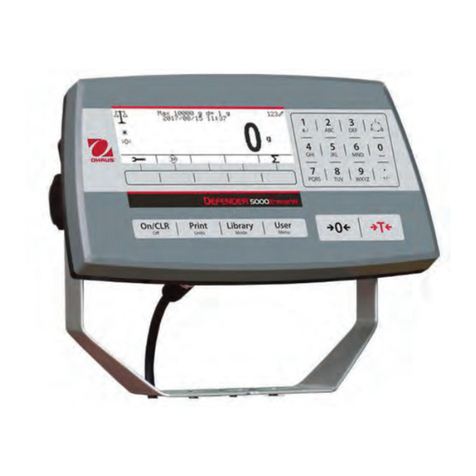
OHAUS
OHAUS Defender 5000 TD52XW instruction manual

YSI
YSI 900 instruction manual

GE
GE Phasor XS Quick reference guide
Orbital Tracker
Orbital Tracker CATV TRACKER OTM750 series manual
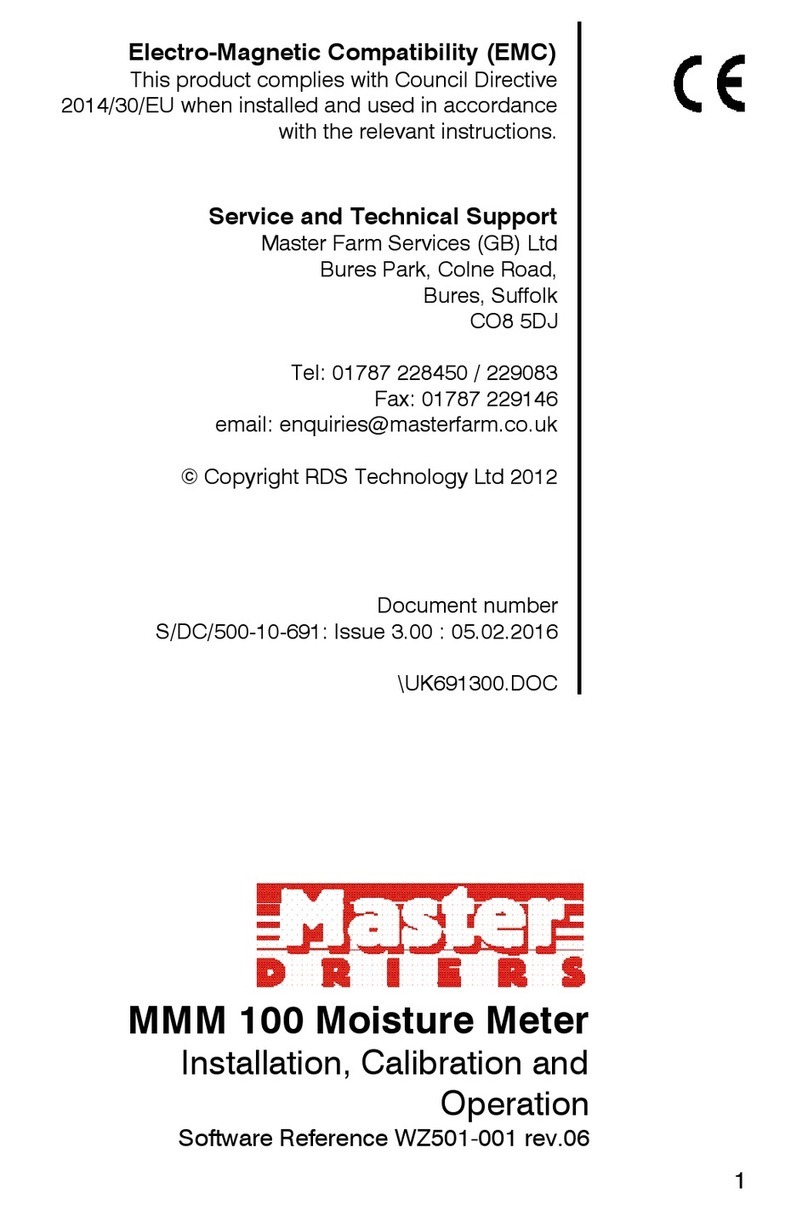
RDS Technology
RDS Technology Master Driers MMM 100 Installation, Calibration and Operation
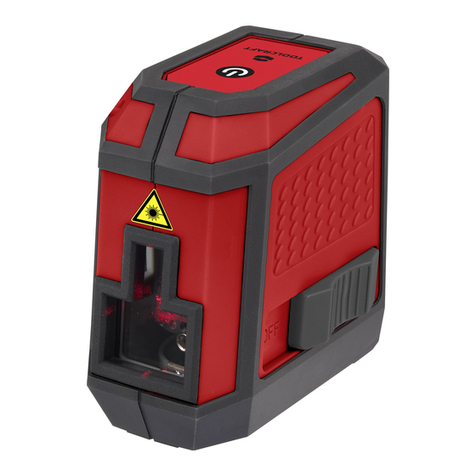
TOOLCRAFT
TOOLCRAFT 1761447 operating instructions
